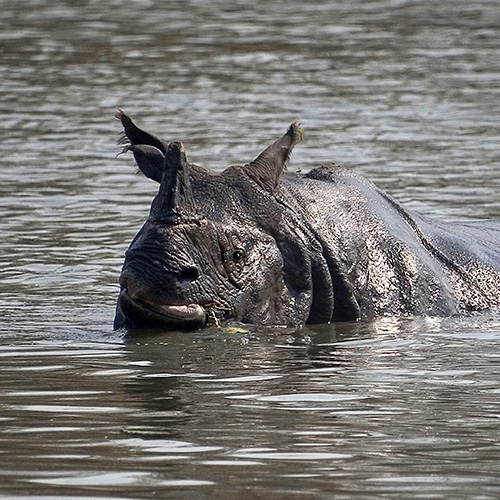Importance of annual floods in floodplain ecosystems like Kaziranga National Park in India

The state of Assam in northeastern India is blessed with two major rivers, Brahmaputra – the fourth largest river in the world flowing from east to west of Assam – and the Barak River in the south of Assam. The floodplain ecosystems along the Brahmaputra river are a prime habitat for the greater one-horned rhino. During the monsoon season, generally June to September each year, Assam experiences annual floods that can be challenging to both humans and wild animals. Rhino bearing areas along the Brahmaputra river, such as Kaziranga National Park (NP), Orang National Park (NP), Pobitora Wildlife Sanctuary (WLS), Laokhowa WLS and Burhachapori WLS are no stranger to flooding, with flooding occurring nearly every year. Sometimes the flooding is low to moderate, and some years it is much more intense.
Annual floods are often portrayed as detrimental for Kaziranga NP and other rhino bearing areas in Assam, but the reality is that annual floods are essential for floodplain ecosystems. Flooding is the only natural regeneration process in floodplain ecosystems, and the mortality of wild animals, whether it’s hog deers, river otters or even rhinos, is a natural consequence of an age-old, vital ecological process. In fact, it is natural selection in action, creating survival of the fittest. Without the annual flooding that energizes the ecosystems in Kaziranga NP and other rhino bearing areas along the Brahmaputra river, these floodplain ecosystems wouldn’t be able to sustain wildlife, including rhinos. These floods should be seen as an ecological service, not a calamity as some headlines suggest.
Flooding recharges groundwater systems, removes invasive plant species like water hyacinth from wetlands, and fills wetlands and redistributes sediment and nutrients across the landscape. For many species, floods trigger breeding events, migration and dispersal. These natural systems are resilient to the effects of floods. Besides the environmental benefits, flooding also boosts the economy by increasing agricultural and fish production and recharging groundwater resources, among other advantages.

Kaziranga NP has been facing floods since the 1950s. However, never in the history of Kaziranga NP has the rhino population been found to have been affected due to the flooding. In 1966, Kaziranga NP had 366 rhinos when the first rhino population estimates were carried out. Since then, flooding has been a natural annual occurrence in Kaziranga NP, with the rhino population increasing from 366 to 2,613 today. In 1971, Pobitora WLS had 5-8 rhinos, and despite annual flooding the rhino population has grown to 107.The real danger to rhino populations and other wildlife in the area is us humans. With humans making floodplains their homes and inhabiting the high grounds of the area where animals would naturally go during the floods, there are more instances of animal-human conflict that result in a higher number of wildlife deaths.
Some media sources portray floods as detrimental to rhinos when the opposite is true. Shri M.K. Yadava, currently Special Chief Secretary to the Government of Assam, has rightly stated: “Kaziranga will become catastrophic without floods. Floods are the lifeline of Kaziranga. It is nature’s washing machine which through clock & counter clock water movements in its channels rejuvenates the Park. At Kaziranga, animals are natural survivors & best in class.”
Floods are not the “bad guy,” they are part of a natural ecological process. Animals including rhinos have successfully navigated the floods for decades with very few deaths attributed to them. Far more wild animals die every day due to human encroachment, poaching and animal-human conflict. It is normal for the weaker animals to die and for the stronger progeny to survive and carry forward the flag of rhinos. Though it is not pleasant to see rhinos or other animals dying or drowning, it is part of the natural world. What rhinos and other wildlife need is to be able to move and follow their instincts amid this natural ecological process without human hindrance or conflict. In case of annual floods in Kaziranga NP, the casualty can be minimized if we can facilitate free movement of wildlife during high flood, and as such, conservation of Kaziranga NP as a single landscape is crucial.
